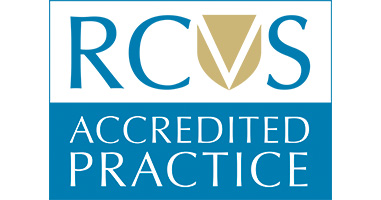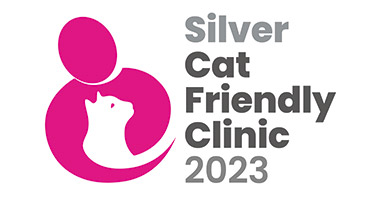Dental disease and management
Dental disease is a very common problem in both cats and dogs, being diagnosed in more than 80% of dogs and 70% of cats over the age of 3 years. Daily dental care at home with regular check-ups and professional treatment as needed is just as important for our pets as it is for us. Prevention of disease is always better than cure but sadly animals cannot brush their teeth. This leads to build up of food debris in the mouth where bacteria grow. Over time the bacteria build up and cause inflammation in the gums, pain, discomfort and eventually tooth loosening and infection.
Common signs include
• Bad breath
• Poor grooming
• Excessive salivation
• Behaviour changes – such as change in appetite, rubbing at mouth, vocalisation can all be signs of dental pain
• Loose teeth or tooth loss
• Swelling around the mouth and face
As with people dental disease can contribute to or increase the risk of other diseases such as diabetes, heart disease and infections of the kidneys.
What you can do at home?
Tooth brushing
Daily tooth brushing is the best method for protecting your pet’s teeth. We recommend that you use a soft toothbrush designed for cats or dogs. You can choose between a traditional long-handled toothbrush or a rubber brush that is worn over your finger. Make sure that you use a special pet toothpaste as the fluoride in human toothpaste can be toxic to pets and most don’t like the flavour or foaming sensation. Veterinary toothpastes come in fish and poultry flavours and are safe to be swallowed. Some also contain enzymes that help to break down plaque. If you wish to be shown how to brush your pets’ teeth you can book in with one of our nurses to assist and advise you.
Successful toothbrushing starts with these easy steps:
STEP 1 - Touch your pet’s face Start with training your pet to accept your hands around their face and mouth. Gently stroke each side of their face ending with lifting their top lip. When your pet accepts this comfortably, you are ready for the next step. Give your pet their favourite treat or toy as reward.
STEP 2 - Touch the Teeth Introduce your index finger into your pet’s mouth while gently stroking the face, lifting the top lip and touching a top tooth (try the canine (fang) tooth on each side). Each day aim to touch an extra tooth until you can touch most or all their teeth. Again, reward your pet their favourite treat.
STEP 3 - Gently Massage the Gums The most important area of the tooth to clean is along the gumline. Change your touch of the tooth to a gentle massage along the gumline. You can use a veterinary recommended finger style toothbrush and toothpaste at this stage. Let your pet sniff and taste the paste first to ensure they like the flavour! Alternatively, dip the brush into some tuna juice or chicken stock to encourage your pet’s acceptance.
STEP 4 - Transition to Toothbrush Your vet can recommend a safe and effective toothbrush specific to your pet’s needs. A Child’s toothbrush is an ideal alternative as the bristles are soft and gentle on your pet’s gums. Things may take a backward step when you first introduce the toothbrush. Therefore, start with the toothbrush Step 2 – touch one tooth at a time until your pet is comfortable again. Then you can start to gently massage along the gumline with the bristles as your pet becomes more comfortable. Have your pet’s favourite treats ready!
Dental chews/treats
If your pet will not allow tooth brushing there is some benefit to using specially designed dental chews and treats. These are designed to gently scrub the outside of the pet’s teeth as they chew. Please discuss with one of the vets or nurses for further advice. We do not recommend bone or raw hide chews.
Dental diets
These may work by mechanically rubbing against the tooth surface to work away the plaque, or by containing ingredients which slow down tartar build up and inhibit bacteria in the mouth.
Book regular check ups
Your pets’ teeth will be assessed yearly at vaccination health checks but if you have concern, please book in sooner for an assessment The vet can advice you on preventative care or discuss treatment options as required.
Types of Dental Disease
Periodontal (gum) disease
This occurs in both cats and dogs as a result of plaque and calculus accumulations on the teeth and may not only cause significant pain and discomfort for affected animals but it may also harm other organ systems if left untreated. Mild periodontal disease can be treated with scaling and subsequent preventative dental care. Severe periodontal disease will require extraction of the tooth.
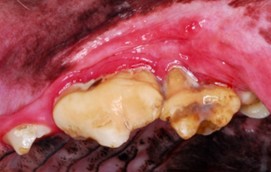
Periodontal disease
Fractures
These occur most frequently in dogs secondary to trauma; commonly road traffic accidents or through chewing bones, stones and antlers. Fractures that expose dentine or the pulp will require either sealant, root canal therapy or tooth extraction as they will be painful and at high risk of developing tooth root infections.
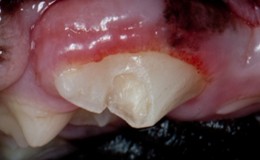
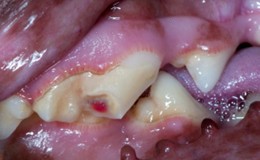
Tooth fractures
Feline Tooth Resorption
Resorptive lesions occur in cats, usually 3 years and older. They can be difficult to identify without x-rays or probing teeth under an anaesthetic. They often appear as a small amount of gum growing out of the tooth and can be very painful. If resorptive lesions are left, they will continue to progress. Dental x-rays can determine the best treatment for resorptive lesions; either extracting the whole tooth and root or removing the crown.
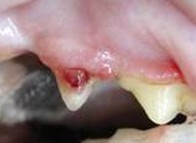
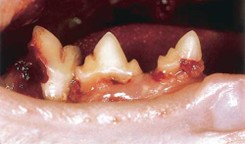
Feline tooth resorption
Feline Chronic Gingivostomatitis (FCGS)
FCGS is a condition affecting cats where both the gums and mouth display an abnormal and usually chronic inflammatory response to oral bacteria. The cause is currently unknown but has been linked to some types of viruses, bacteria and stress. Other types of dental disease and secondary bacterial infection may worsen the condition. Treatment often requires a combination of dental and medical treatment to effectively manage the condition.
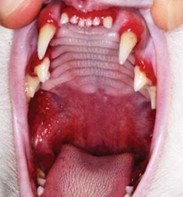
FCGS in a cat
What happens if my pet needs to come in for dental treatment?
All pets undergoing dental treatment receive a full oral examination under a general anaesthetic to determine the full extent of any disease. This involves examining all of the structures of the mouth and assessing each tooth individually by checking for defects and probing the surrounding gum.
Pets undergoing dental treatment may receive scaling, this removes calculus and plaque from the tooth and under the gum line. Polishing is performed if required.
X-rays
Dental x-rays will be recommended to determine if there is any hidden disease not visible in the mouth. A third of all dental disease may only be found through x-rays.
X-rays are recommended in all cats to rule out resorptive lesions.
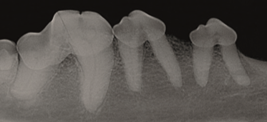
Extractions
Extractions may be necessary for diseased teeth based on examination and x-rays.
Simple extractions are appropriate in severe periodontal disease when minimal tissue is holding the tooth in place. Surgical extractions may be required to remove teeth which are not loose; sutures are then placed in the gum which do not need to be removed.
Costs
We will aim to produce an accurate estimate of the cost based on an initial examination. However, it is often incredibly difficult to assess the extent of your pet’s dental disease and thus make an appropriate treatment plan until they are anaesthetised and had a thorough examination, often including dental x-rays. This is why we will give you a range for your estimate. This should also account for if your pet needs to stay in overnight for any additional pain relief.
Aftercare
Your pet will usually go home the day of their dental treatment with any further medication needed. You will be asked to revisit the practice to check their mouth within the first week. Preventative dental care can then be used to reduce recurrence which one of our nursing team can demonstrate for you.


